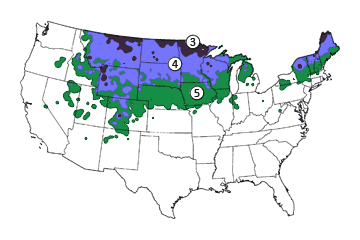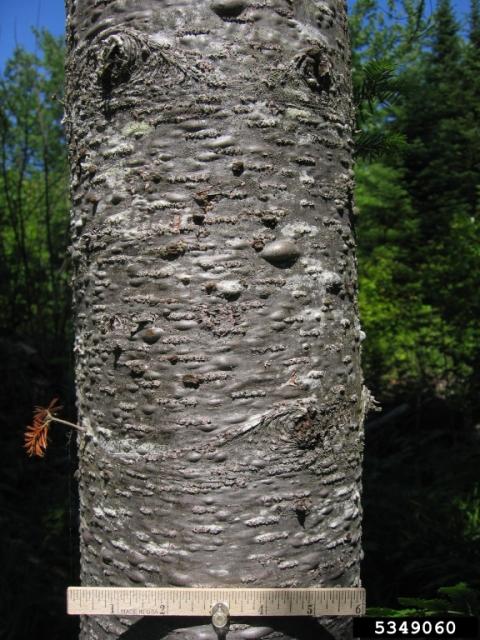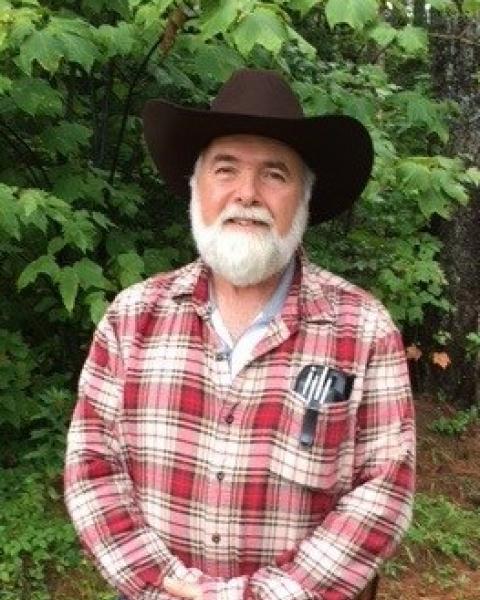Balsam Fir
As we think about seedlings and plantings this time of year, since approximately 2/3 of the seedlings ordered here in Coös County are balsam fir, let’s talk about that tree species. The balsam fir is a native evergreen well-adapted to the colder climates of the northern United States and Canada. It is a small to medium sized conifer found in the boreal forests of these northern areas. Evergreen meaning that it keeps its needles throughout the year, and conifer meaning the seeds are produced within cones. These cones will dry and open in the fall and allow the seeds to be cast throughout the forest or be moved from place to place by birds and small mammals.

Elmer Verhasselt, Bugwood.org
Balsam fir cones
The cones are 2-4 inches long that start out a purplish color and turn a gray-brown when they mature. They also are quite resinous throughout most of the season. These cones also stand erect on the branches rather than hang below as many other conifers. The symmetrical spire-like crown, shining dark green color (which at times can have a bluish tint to it), and pleasant fragrance, have made the balsam fir a favorite Christmas Tree for hundreds of years. The needles will also remain on the branches, and maintain their coloring, for longer periods of time than most other conifers, which adds to its preference for Christmas Trees, wreaths, and other holiday greenery. The balsam fir naturally grows here in northern New England and can be expected to do well in Hardiness Zones 3-5.

Hardiness Zones 3-5
These trees do well in full sun or partial shade, meaning that it prefers a minimum of four hours of direct sunlight each day. Newly started seedlings prefer sheltered areas for the first year of growth. Typically, balsam fir prefer moist, cool, but well-drained areas, and sandy, loamy, and more acidic soils to thrive and grow healthy. Early on after planting, it is important to water your seedling weekly until it gets firmly established. These trees soak up lots of water so be sure to water frequently, but not quickly. Water should be released slowly over time which will aid in the ability of the tree to absorb and use it. If planting for Christmas Trees, plant far enough apart to provide room for tree crowns to develop for approximately 10 years. Also allow adequate space for maintenance and mowing between trees. A 6’x6’ spacing is the standard for Christmas tree plantations, which translates into 1,210 trees per acre.

Keith Kanoti, Maine Forest Service, Bugwood.org
Balsam fir is readily identified by its aromatic foliage, grayish brown bark with resin pockets or blisters.
If planting for windbreaks and visual barriers, place trees so that tree crowns will fully develop, and branches remain alive close to the ground. The spacing is different for this application because trees will remain for their entire life span rather than the 10-15 years or so that Christmas trees are grown. Plant these balsam fir seedlings at least 10 feet apart and in groups or rows. Row planting often requires two or more staggered rows to provide the desired barrier. At times, twice the number of trees are planted to provide a quick barrier or screen. Every other tree is removed when they start to compete with each other.
If planting to establish or reestablish a forest area the spacing will be similar to that of the Christmas tree plantation. This spacing is a goal and may not be achieved due to existing ground and forest conditions. The goal here is to grow tall straight trees. Periodic management may need to be done to help keep the trees healthy and strong.
Whatever the reason for planting balsam fir seedlings, or for managing your existing forest in general, please feel free to contact me and I will do my best to help guide you to the appropriate management that will get you to your desired goals. Forests are renewable and with a little care and maintenance, may provide us with generations of enjoyment and use.


